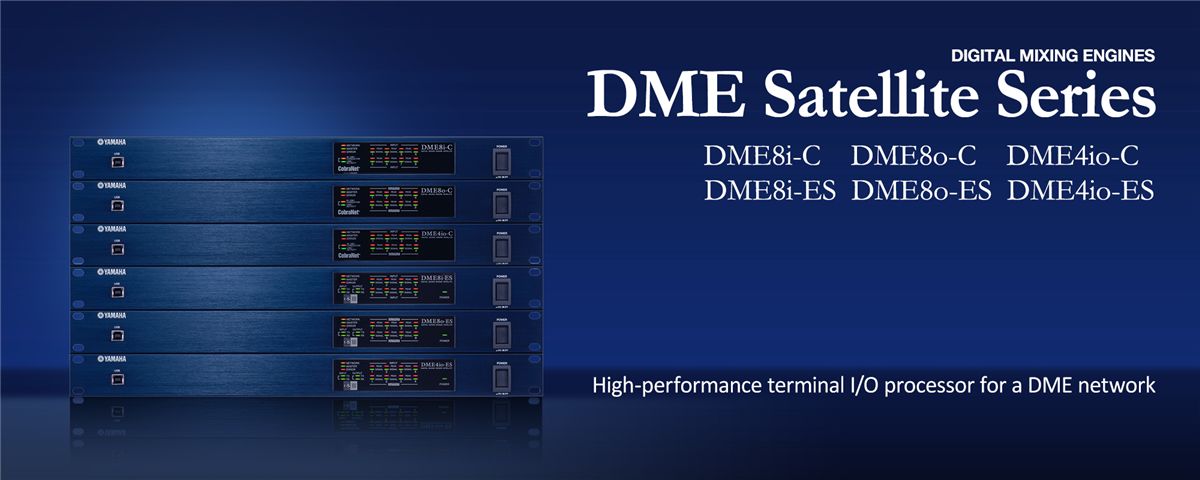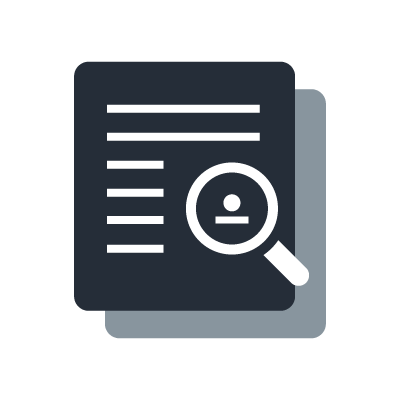DME Satellite Digital Mixing Engine Satellite
DME64N / DME24N Features
Ideal for Expanding DME64N or DME24N Based Systems
The DME Satellite units are network interfaces that provide analog inputs, outputs, or both. Select the DME8i, DME8o or DME4io according to the remote I/O configuration you need. You have a choice of CobraNet™ ("-C" suffix) or EtherSound ("-ES" suffix) networking to optimally match the requirements of your application or an existing network infrastructure. Both network types allow up to 64 audio channels to be transferred over a single Cat-5 Ethernet cable, significantly reducing cabling infrastructure and cost requirements.The CobraNet™ based DME Satellite C series offers maximum advantage in redundant or VLAN type switched networks, and is primarily suited to complex installed systems. The EtherSound equipped ES series offers exceptionally low latency and easy setup that makes it the perfect choice for temporary sound reinforcements systems.
Plenty Of Processing Power for Stand-alone Applications
The DME Satellite units incorporate the same original Yamaha DSP7 digital signal processing LSI that powers our top-of-the-line digital mixers. Using the DME Designer software application on a personal computer it is possible to combine EQ, crossover, delay, and other components to create any type of system your application requires. In fact, in a single 1U rack space the DME Satellites offer approximately 80% of the processing power provided by the DME24N Digital Mixing Engine, so you have plenty of stand-alone processing power.* The SPX effects that are included in the DME64N and DME24N are not included in the DME Satellite models.
Superior Sound and Reliability from a World Leader in Pro Sound
If your only criterion is system efficiency there are numerous choices you could make. But if sonic quality and reliability are important as well, Yamaha has a great deal to offer.In addition to full 96 kHz capability, the DME Satellite series benefits from unparalleled audio quality that is due in part to Yamaha's extensive experience and know-how in microphone preamplifier, AD/DA, power supply, and grounding design. They also feature much of the same proven circuit and DSP technology that is used in Yamaha pro audio gear that is acclaimed for its outstanding reliability in demanding live sound and broadcast applications around the world.
Ideal for Small Systems as well as Large Distributed I/O Systems
All three models in each series include a 16-in/16-out CobraNet™ or EtherSound interface. The DME8i and DME4io analog inputs feature remotely controllable microphone preamplifiers. Whether it's a minimal system based on the DME4io, a delay tower distribution system using DME8io units directly fed from the mixer, or a large scale system based on DME64N or DME24N Digital Mixing Engines with DME Satellite units used for distributed I/O and minimal processing, the DME Satellite series offer scalable solutions that make setup fast, flexible, and reliable. Of course you can also combine the DME4io with DME8i or DME8o units to create 12-in/4-out or 4-in/12-out configurations as required.
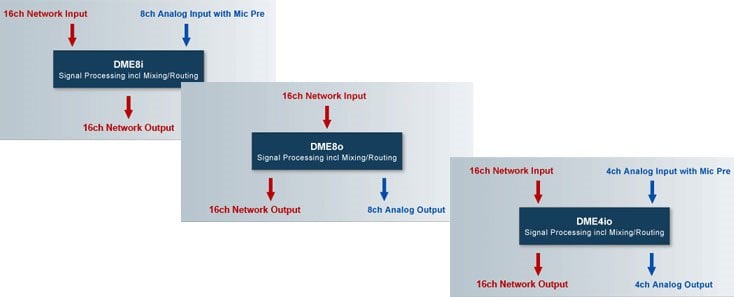
All three models in each series include a 16-in/16-out CobraNet™ or EtherSound interface. The DME8i and DME4io analog inputs feature remotely controllable microphone preamplifiers. Whether it's a minimal system based on the DME4io, a delay tower distribution system using DME8io units directly fed from the mixer, or a large scale system based on DME64N or DME24N Digital Mixing Engines with DME Satellite units used for distributed I/O and minimal processing, the DME Satellite series offer scalable solutions that make setup fast, flexible, and reliable. Of course you can also combine the DME4io with DME8i or DME8o units to create 12-in/4-out or 4-in/12-out configurations as required.
Comprehensive Control Terminals
The rear panels feature RS232C/422 terminals that can be used to connect AMX, CRESTRON, or similar external remote controllers, as well as providing gain control for Yamaha AD8HR AD converters with remotely controllable microphone preamplifiers. An 8-in/4-out GPI terminal allows connection of GPI interfaces or external switches, and an Ethernet connector is provided for connection to an ICP1 Intelligent Control Panel or a computer running the DME Designer application. A USB port is also provided specifically for communication with DME Designer.

The rear panels feature RS232C/422 terminals that can be used to connect AMX, CRESTRON, or similar external remote controllers, as well as providing gain control for Yamaha AD8HR AD converters with remotely controllable microphone preamplifiers. An 8-in/4-out GPI terminal allows connection of GPI interfaces or external switches, and an Ethernet connector is provided for connection to an ICP1 Intelligent Control Panel or a computer running the DME Designer application. A USB port is also provided specifically for communication with DME Designer.
DME Designer for Flexible System Construction and Centralized Control
Using the DME Designer application software - the same program that is used with the DME64N and DME24N - the DME Satellite ES series models can be configured with a wide selection of processing components, up to the limit of the unit's processing power, for flexible creation of systems for installed or temporary applications. DME programmability frees you from the constraints of fixed-function analog devices, making it easy to accommodate sudden system changes during setup as well as expansion once the system has been set up. And you can program and control all units on a network from a single location.The intuitive, easy-to-use DME Designer application is available as a free download from the download page.
Basic Control Panel Options
The DME Satellite series can be controlled from any standard GPI controller, but Yamaha offers a range of Ethernet and GPI based control panels and fader/switch panels for fuss-free system setup. The ICP1 is an intelligent control panel with an LCD interface that can display information in five different languages (English, German, French, Spanish, and Japanese). The ICP1 installs in a standard wall-mount conduit box, controls assigned DME parameters via a single Cat-5 Ethernet cable, and can be easily set up to meet the requirements of any type of end user. There are also the GPI-based CP1SF control panel with 1 switch and 1 fader, the CP4SF with four switches and four faders, and the CP4SW with four switches. These controllers can be used for convenient remote scene switching, microphone on/off switching, microphone or BGM level control, and more.
DME Components
Yamaha DME processors include a variety of components for an extensive range of applications. There are crossovers and other speaker processing essentials. Dynamics processors such as companders, compressors, and gates are indispensable for general audio processing. EQ is necessary in most applications, so a dazzling array of equalizers is provided. WAV players, event schedulers, and other functions provide advanced capabilities and operability for commercial installations. For effortless speech processing there's Auto Gain Control. A Room Combiner facilitates flexible zoning for applications such as hotels and banquet halls. And automated functions like the Program Ducker can be a huge advantage for live broadcasts. No matter what the application, there are DME components that will significantly enhance performance and efficiency.
Speaker Processing

Speaker processing can be essential for achieving maximum performance from professional speaker systems as well as for delivering optimum sound quality throughout the listening area. DME processors include everything needed for precision speaker tuning and room matching: versatile crossover processors with APF (All Pass Filter for phase control), horn EQ, delay, limiter functions and more.
Room Combiner

The Room Combiner component adds multiple audio signals to "virtually" combine the acoustic spaces of multiple rooms. Mono and stereo components that combine 4, 8, 12, or 16 rooms are available. This component provides an effective solution for situations in which several rooms or areas can be physically partitioned or combined to handle different types of events or numbers of participants. Sources and outputs can easily be switched as required, and the processing for multiple areas can be handled by a single DME unit.
Auto Gain Control

This function automatically adjusts gain to maintain a consistent level even if the volume of a speaker's voice varies, for example. An indispensable function for meeting rooms and conferences.
Auto Mixer
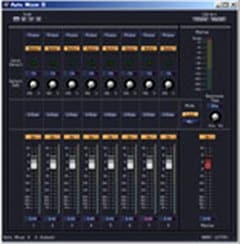
The Auto Mixer II component provides an over-ride function and automatic output level control make it possible to create "intelligent" systems that provide automated control for applications that don't require the presence of an experienced operator.
Program Ducker
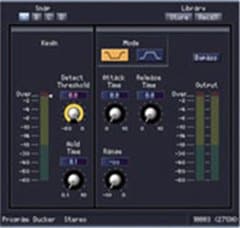
The Program Ducker component features significantly longer attack and release times. Mono and stereo types can be flexibly configured to accommodate a wide range of applications. The Program Ducker offers all the versatility required for installations ranging from banquet halls to theme parks, while additionally providing camera tally link capability for broadcasting - a field in which the DME series is finding increasing acceptance.
Event Scheduler & Wav File Player
As their names imply the Wav File Player component plays specified Wav audio files, and the Event Scheduler can be used to trigger it at predefined times and repeating cycles. This could be used to play opening and closing themes for a retail outlet or mall, for example. Event Scheduler triggering is not limited to Wav File Player operation, however, and it could be used to schedule a GPI output that could start an external CD player or other device, for example. Programming the scheduler is easy, and can be done by the end user simple via wall-mounted remote control units or other remote controllers. Playback level and on/off switching can also be accomplished via the same type of controller.
Ambient Noise Compensation(Version3)
The new Ambient Noise Compensator component can be used to measure ambient noise levels and automatically and dynamically adjust the program level for optimum balance and intelligibility. This function can be useful, for example, to optimize the level of announcements at shopping malls at which the ambient noise level may vary greatly depending on the time of day or day of the week.
V4 Features
Caution: The hardware specification for DME Firmware V3.5x or earlier differs from the one for Firmware V3.8x or later. Therefore firmware V3.5x or earlier cannot be upgraded to V3.81 or later (including V4.0). If you need to upgrade your DME from V3.54 or earlier to V3.81 or later (including V4.0), please contact your Yamaha dealer.
New Component of DME V4.0
Partial Recall
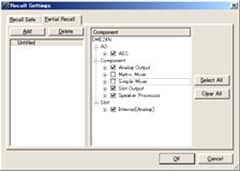
"With V4.0, Scenes now have a partial recall capability. So Scenes can be created that only recall one or more components

